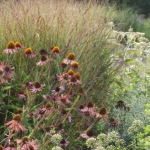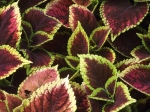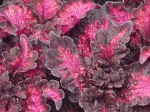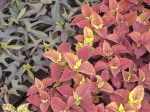

Prairie plants such as
Echinaceas and grasses dominate at Lurie Garden.
Bees are busy and hard at work at one of the best kept
secrets in Chicago. Hidden away in Millennium Park is a quiet
oasis–Lurie Garden. Consisting of 5 acres and tended by one paid
staff person I was impressed by how natural the setting was.
Another great thing about Lurie Garden is that it rests atop the
Millennium Garden parking structure. Yeah, it is also a rooftop
garden! Is that making the most of your space and hiding an eyesore
all at once?

I met garden writer Helen
Yoest (gardeningwithconfidence.com) and garden photographer
Christopher Tidrick (fromthesoil.blogspot.com) at the
symbolic “Cloud Gate” (Anish Kapoor, 2006).
With its mirror like finish, this giant sculpture
lays between the vertical and the horizontal; the organic
omphalos refered to by citizens as the “Bean”. On this
glorious August morning, sun shining bright, the mood of
the trio was festive and we were hungry to bite into what Chicago
had to offer. Helen looked forward to seeing this piece as she had
never been to chicago and has a penchant for gazing balls. The
‘Bean’ is one big gazing ball that’s for sure. A few pictures
snapped and off we went to the one garden the three of us
wanted to see. What made that sharing more of an event is the
company I got to share it with.

Christopher Tidrick is
always on the lookout for a great garden shot. Screens or
scrims of grass create great layers and afford the photographer
endless possibilities.

Helen
Yoest- Spendor in the grasses. Textures of stone, plants, wood and
water were awaiting our discovery. This is one garden Helen did not
want to miss in Chicago.
Upon
entering through the armatured hedge the three of us were
amazed at the insular world before us. Textures of stone,
plants, wood and water were awaiting our discovery as we walked
through the small hedge opening, a snicket almost, but I could
be mistaken. Through the hedge we went and momentarily I felt that
we had stepped through the looking-glass. As a big fan of
the natural garden, I could easily glide through meadows and along
the shorelines taking it all in. Lurie Garden is right up my alley
that’s for sure. Prairie perennials, grasses and great
textural plants from the plains mix well with other plants. OK,
Stop!
I am describing it as a
jumble, but its more like a series of rolls. Screens or scrims
of grass created great layers while Echinaceas,
Hemerocallis ‘Chicago Apache’,
Veronicastrum virginicum and
Eupatorium maculatus
‘Gateway’ stood tall and proud showing the world their
colors. Calamintha,
Pycnanthemum muticum,
Eryngium yuccifolium,
and
Amsonia hubrichtii
providing contrast and
interest. Layers and screens, screens and layers. More movement
seems to happen while everything is standing still in this
space.
 Just one
Just one
August morning is not enough for this garden. It must be visited
several times throughout the seasons. This is a great garden to
study in, have lunch, meet a friend for intimate conversation.
There is an other-worldliness about it. NO place in Chicago feels
like this.
A visitor to Lurie Garden will be
treated to not only a slow quiet pace, but a feast. The bees
certainly are. The bees in Lurie Garden don’t pay visitors any
attention. They are far too busy gleaning what they can and
collecting up what they need to survive the winter. Busy, busy,
busy bees. This is sort of ironic to me. The bees are much like the
humans who work around or outside the garden. I am not talking
the park employees, but those working in downtown Chicago. Outside
the shouldering hedges is a busy area of downtown. Thousands of
people are working and doing their thing so they can survive as
well. 
September 9, 2011 | Categories: Garden, op/ed, Plants That Rock | 1 Comment
Adaptation is a rule, and a lesson, that almost every gardener must learn. Where to plant, what to plant there, zoning, and watering are all thing that a gardener must keep in mind when purchasing a plant.
Native plants–native to your area or to the North American continent– can be so rewarding with minimal effort. The same holds even more true with plants that are native to the plain states.
European garden designer Piet Oudolf capitalizes on just those qualities that are so natural to the plant.
American gardeners, always in search of value and savings=maximum bang for the dollar, are discovering the qualities of native plants.
Rewarding the gardener with growth and blossom native flowers such as monarda, eupatorium, echinaceas, rudbeckias, and asters add color and texture to any landscape. Even my favorite hibiscus moscheutos are great, showy native plants. These flowers can be easily complimented with native shrubs such as hydrangea quercifolia, viburnum trilobum, and physocarpus.
Producers such as American Beauties really help a small retailer like myself locate and source a lot of the native plants.
I don’t know about you, but I am learning what my time is worth. North Creek Nurseries and American Beauties help me to find plant that my customers love.

August 17, 2011 | Categories: Garden, nursery, Plants That Rock | Tags: native plants, Nursery | Leave a comment

This slideshow requires JavaScript.
The
Hot for Hibiscus event is something that has grown slowly here at Heavy Petal Nursery. This is not the first year I have held this event– it has become an annual thing.
Last year I had a couple of friends come help, the weather was cool and I was forcing the hibiscus to bloom in the greenhouse. We had to haul them all out of the greenhouse the morning of the event, but what a show when the blooms started to open! This year I don’t have that problem, though it is cool again. Odd weather. This year I also have a few friends I have invited to come vend. One of my friends specializes in ferns, and the other is an expert in clematis. I have also invited a few artisans.
Please enjoy a few of the pictures I have assembled into a slide show at the bottom of the page.
Hardy hibiscus, Hibiscus moscheutos, commonly refered to as swamp mallow, rose mallow, or sea hollyhock are showy perennials for any garden. I will remind everyone again I am in USDA zone 5.
Hibiscus m. are late to awaken, usually rising from the ground when it becomes warm (about the time you plant tomatoes) and then they grow with the heat. Dependable bloomers, plants tend to start blooming in my area (zone 5) in late July and keep going till the first heavy frost. Feed them heavily when they start to come up. Slow release fertilizer is fine, manure tea is great as it is there for those hungry awakening roots. You can pinch them back if you want to keep them to size. This also promotes side shoots which equal more branching and more blossoms. I try to dead head my plants to keep them clean and keep them blooming.
In the past I have been raising about 600 hardy hibiscus plants yearly. This year I am raising around one thousand and have about 250 seedlings that I am working with. Yes, a small breeding program—something new for me, but an adventure none the less.
Now I get asked questions all the time like—do they spread?
The answer is not really. They have a central base root and each year produce more canes off this center. They are not going to be invasive, misbehave, or takeover.
Where do I plant one of these hibiscus in my garden?
Well, they are a tall perennial—so back of the border. I have seen them easily reach six feet. I suggest planting them in a hot spot in your garden, or an area that receives a lot of sun. Please don’t put them someplace where they are kept cool and shady.
How much water do they need?
Well, I am in the desert so I would say keep the soil moist. I would say that anywhere with most perennials, but they also have a fantastic root system and could go through short periods of drought if they had to. I have seen a garden that the people moving and put their house up for sale. The person tending the house neglected most things, but the not the lawn. Shrubs and perennials looked dry, but the hibiscus still bloomed. Not the same way as if they were well-tended, but they did bloom.
Customers come up to me and start to talk about the hibiscus they purchased the previous year. Cringing as I am expecting the worse, they proceed with their tale, but it tends to be the opposite. One woman started in on me that her hibiscus was too big for the spot, had already gotten taller than the fence and was pushing other perennials aside. What should she do? I suggested moving the perennials and buying a few more hibiscus. That is exactly what she did and is very happy about it.
Hardy hibiscus are not plants for those who are meek gardeners or weak at heart. They are lusty plants. People see them at my booth at the local farmers market—
This slideshow requires JavaScript.
flowers become objects of desire. Reds leer out at passers-by, pinks sparkle, mauve and plums seduce. The flowers are commonly refered to as dinner plates because of their rounded shape and size, but there are several varieties that are lobed like the classic hibiscus we all think of.
I only sell one white variety—Blue Danube II. It is clean, and clear, has no red ‘eye’ and the foliage has a slightly different tint that comes off as blue next to the white plate size blossoms.
Foliage is also another thing to look at when purchasing your hardy hibiscus.
I recall as a child that the only foliage I really saw was a green leaf that reminded me of a Tilia (little leaf linden) but some of the foliage may just more interesting than the flowers themselves. Kopper King and Plum Crazy were a couple of the first I grew with colored foliage. Kopper King has maple-like leaves and the white blossoms with red veins and ‘eye’ just pop on these plants. Plum Crazy is double named. The foliage is plum tinted but so are the flowers—plum with a deep plum eye. Summer Storm with the leaves ranging from maroon to black-purple with clear cotton candy pink blossoms with a red ‘eye’. Fireball, a smoky red bloomer with burgundy blushes to the foliage. The foliage can be quite lovely in the mixed border before the blossoms ever appear.
In the United States these plants are widely grown from Massachusetts to Michigan, southwards to Alabama, Georgia, and Florida. In southern states Hibiscus coccineus is more common being the native swamp mallow found in tidal marshes.
On the west side of the Rockies I have seen them in Boise and here in the Pacific Northwest. I remember seeing them in central California as a kid too. To me they are a great ‘Steam Punk’ Garden plant. They pay homage to the Victorian gardens of the late 19th Century but are definitely contemporary as well. Hardy hibiscus fit my aesthetic.
Enjoy and Happy Gardening!
This slideshow requires JavaScript.
July 20, 2011 | Categories: Garden, nursery, Plants That Rock | 1 Comment
Coleus are great plants for containers. I cannot resist using them in almost all the summer planting that I do for myself or for clients.
I have had many people come up and ask me what I am planting? Their bright-colored leaves make people curious. When I say they are coleus the reaction I get most often is—”Aren’t those shade pants?”
Well, yes, some are shade plants. The Kong series are shade plants with their huge leaves. They need those huge leaves to capture the filtered light. But the small-leaved varieties are great sun plants. I live in the desert, we don’t have shade.
When I plant coleus in containers I like to drench the roots. This season I have been drenching them in Haven Brand Moo Poo Tea giving the coleus the best advantage to establish. I would suggest feeding them the tea at least once a month throughout the summer. I am starting to become a big believer of the Moo Poo Tea.
Bright and ‘designer’ in feeling, don’t let the sun frighten you from planting these tough little plants.
May 26, 2011 | Categories: nursery, Plants That Rock | Leave a comment



 Just one
Just one











